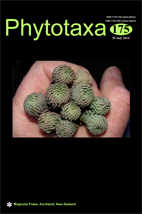Abstract
As part of a taxonomic revision of the genus Massonia Houtt., a new species, Massonia dentata Mart.-Azorín, V.R.Clark, M.Pinter, M.B.Crespo & Wetschnig, is here described from the Nuweveldberge on South Africa’s southern Great Escarpment. This new species is, at first sight, related to M. calvata Baker and M. echinata L.f., but it differs in floral and vegetative characters, such as the dentate perigone segments and bracts, leaves with numerous emergences, each bearing a thickened trichome, as well as in its ecology and distribution. A complete description of the new species and data on its biology, habitat, and distribution are presented. The close relative Massonia calvata Baker, an overlooked endemic from the Sneeuberg Centre of Floristic Endemism in South Africa, is lectotypified.

